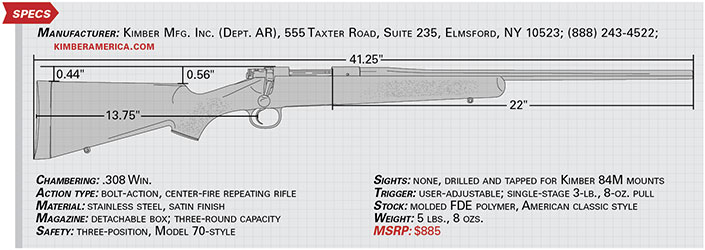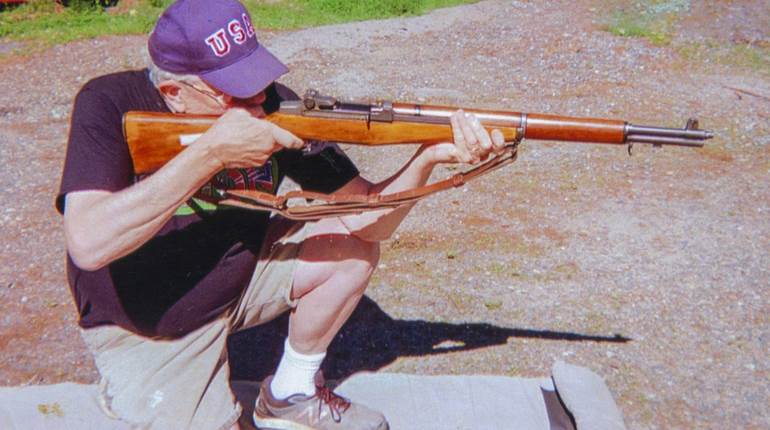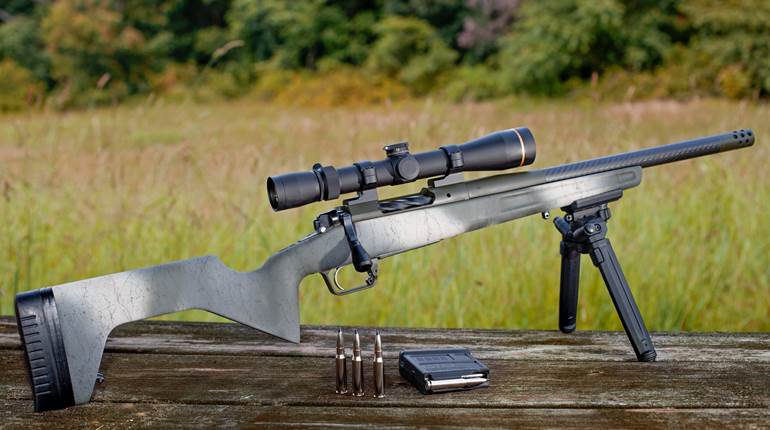
In my business, colleagues and I often grouse about what we call “the race to the bottom”—manufacturers vying to see who can produce the least expensive sporting rifle. No need to name names; examples are obvious and include most of the more popular brands. Traditionalists can gripe, but this is an amazingly good deal for America’s riflemen. If I wanted to put together a really accurate center-fire rifle I’d probably start with a top-of-the-line barrel from a known producer of extra-good barrels, and I’d probably pay up to $600 for the barrel blank alone, not chambered, threaded or crowned—just rifled and contoured.
We can all think of several complete rifles in that price range, and a few that, at realistic “out-the-door” prices, aren’t much more than half that. Honestly, I don’t know exactly how the manufacturers do it, but an awful lot of those rifles will shoot just as well as my “pet project rifle” based on a barrel costing as much as many complete production rifles.
The new Kimber Hunter is not exactly in this race. With a suggested retail price of $885, on today’s market it’s very much a mid-priced bolt-action, with many production rifles priced quite a bit lower, and some a whole bunch higher. The Hunter is, however, one of those production rifles that could definitely compete in accuracy with my imaginary project rifle. It comes with a sub-minute-of-angle (m.o.a.) guarantee and a test target validating that guarantee (“3-shot group of .99 or less at 100 yards … using factory ammunition”). At retail, the injection-molded, synthetic-stocked Hunter is priced about $500 less than Kimber’s Montana, and is about half the price of Kimber’s Adirondack, both rifles also feature synthetic stocks that are hand-laid, unlike the Hunter.

LIGHTS, CAMERA, ACTION
Whether stocked in walnut or synthetic material, Kimber rifles have always been “premium” production rifles, upgraded in fit and finish. Nonetheless, the basic Kimber difference has always been the action. Long before Kimber’s current (and extensive) line of M1911-based handguns, the Kimber rifle was born in a time when the long-beloved, controlled-round-feed, pre-1964 Model 70 was gone and all Model 70s were post-1964 push-feeds. Using then-new CNC machining, the Kimber action was created as, essentially, a pre-1964 Model 70 clone. It has the long, Mauser-style extractor, fixed mechanical ejector, three-position Model 70-style cocking-piece safety and is very much controlled-round-fed.
As the Kimber rifle evolved, the other big distinction is that, again using CNC machining magic, the Kimber bolt-action has been uniquely sized to fit specific families of cartridges. For .30-’06 Sprg.-based head diameters, for instance, you will find that the Kimber bolt and receiver are of smaller diameter than most, thus the action is trimmer and lighter. Kimber offers four distinct actions for its various grades and models of rifles: 84M, essentially the .308 Win. family but long enough to also house 7x57 mm-based cartridges; 84L, the .30-’06 Sprg. family; 8400 Magnum, belted magnums up to .375 H&H Mag. and .458 Lott; and 8400 WSM for the short, fat Winchester Short Magnums. To this day, that latter action, the 8400 WSM, is one of very few actions actually designed for the fireplug-shaped short magnums.
Right now, allow me to give you my biggest complaint about all Kimber rifles: I’m left-handed, and Kimber doesn’t offer a left-handed action! I keep hoping, but even so, I have a long history with Kimber rifles. I’ve used them all over North America and around the world. They have accompanied me on numerous memorable hunts, and have accounted for some of my favorite animals. Let’s understand that the Kimber is a production rifle, so there’s a variance: some will be more accurate than others. However, I’ve always had good—and sometimes exceptional—accuracy from Kimbers, even though, as a lefty, I have to reach over the top to work the bolt. They use good barrels, have good triggers and the basis is always the maker’s traditional and classic controlled-round-feed action.
In accepting a significantly more affordable Kimber rifle, it’s important to understand that neither the action nor the barrel were changed or compromised. The Kimber Hunter uses the same barreled action that might be used on a different Kimber model costing twice as much or more.
The initial Kimber Hunter is based on the Model 84M action in stainless steel only, with a 22" barrel. Obvious manufacturing savings include limited options, and unlike many Kimber models the muzzle is not threaded and a detachable muzzle brake is not included. Initially there are five cartridge options. Three you would expect— .243 Win., 7 mm-08 Rem. and .308 Win.—and two are excellent surprises, 6.5 mm Creedmoor and the great old .257 Roberts. This is where the 84M action pays a dividend; the Roberts is based on the 7x57 mm case necked down, and a true .308-length short action would not house it. This choice of action gives Kimber the opportunity for growth in the Hunter line without modifying the stock or magazine.
BOTTOMS UP
The big difference between the Hunter and other Kimbers, and a contributing factor in the rifle’s lower price, lies in the bottom metal: There isn’t any! The stock is precision-molded of flat dark earth polymer, with the action screws pillar-bedded and the barrel free-floated from 2.5" ahead of the shank. Other Kimber sporting rifles are a mixture of traditional hinged floorplates and blind magazines. The Hunter uses a detachable box magazine with three-round capacity. The magazine has a small extension on the rear that fits into a recess above the forward portion of the trigger guard bow. The spring-loaded magazine catch is part of the magazine, on the bottom front surface.

The magazine works simply and well, but there’s only one way to seat it: With the magazine angled upward at the back, insert the rear of the magazine into the well, and then rock it upward until it locks into place. In operation it’s very fast and positive, and spare magazines are available—but it’s a good idea to practice seating the magazine on the range to avoid fumbling in the field.
The molded stock incorporates the trigger guard. In keeping with Kimber’s classic tradition, the final version is a rounded trigger guard bow. If you happened to see an early prototype version at a show, the original was, well, something else. As one editor I work for quipped, “You can write about the Hunter as soon as they fix that hideous trigger guard.” They did. The lines of the stock, including the trigger guard, are pure American classic, straight buttstock, nicely laid-back pistol grip, gently rounded fore-end with rounded tip.
So, the action is simply that, a rounded receiver, secured to the stock by two hex-head screws in pillar fixtures. The detachable magazine, of course, incorporates the follower and spring; and, with the controlled-round system, feeding was extremely smooth and positive. Obviously the molded stock and detachable magazine create cost savings in both parts and assembly, but there’s also a weight savings.
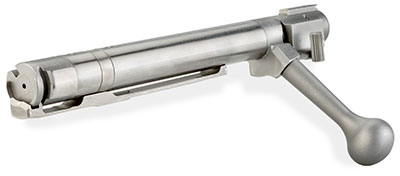
LIGHT IS RIGHT
Kimber has long been famous for exceptionally light hunting rifles. The company’s long-action Mountain Ascent weighs 5 lbs., 8 ozs.; the Adirondack on the same 84M action as the Hunter weighs just 4 lbs., 13 ozs.—about as light as a factory bolt-action can be made. These incredibly light weights are accomplished by a very light (and costlier) stock, but, in the case of the Adirondack, also by a short 18" barrel. The Kimber Hunter weighs 5 lbs., 8 ozs.—the same as the Mountain Ascent—and is still very light, especially given its 22" barrel of slender, but not pencil-thin, contour.
So, out of curiosity, I took the Hunter apart and weighed the (few) pieces. The stock weighs 2 lbs. Synthetic stocks are not by nature always lighter than wood; it depends on dimensions, material and construction. A 2-lb. synthetic stock is not especially light, but the Hunter stock includes the integral trigger guard bow and a full-size 1" Kimber recoil pad. The magazine has a sheet metal body with polymer follower and bottom with an articulated release lever. It weighs right at 4 ozs. This leaves a tidy
3 lbs., 4 ozs., for the steel bolt, barrel, receiver and action screws, for a modest total weight of 5 lbs., 8 ozs., for the test rifle, chambered to .308 Win.
Since the receiver is simply an 84M action, any and all standard scope mounts for that action work. I used two-piece mounts, fairly light, but in order to give the rifle its best chance to meet its sub-m.o.a. guarantee I put a full-size 2.5-10X 50 mm Zeiss Victory HT with 30 mm tube on the rifle. This brought the total “shootin’ weight” up to 7 lbs., 8 ozs.—no longer a bantam weight, but a nice complete weight for a .308 Win. hunting rifle.
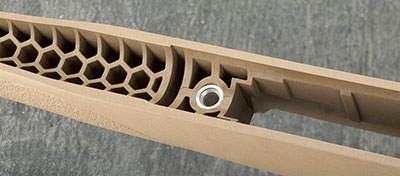
MEETING THE M.O.A.
If I were to choose a chambering for a test rifle that I wanted to shoot really well, I would choose a .308 Win. Honestly, I’m not a huge .308 fan—the other four Hunter chamberings are far more interesting to me personally—but the .308 Win. is an exceptionally accurate cartridge, and also wildly popular.
As I said, the Kimber Hunter comes with a “hang tag” stating its sub-m.o.a. guarantee and a test target. This one came with a very fancy test target. Well, if I was shooting test targets with a .308 I’d use match ammunition, so it was no surprise that the test target was shot with Federal and Winchester match loads, both with 168-gr. hollow-point boattail bullets. The Federal group measured 0.42"; the Winchester group 0.51", on average comfortably better than one-half m.o.a. Do I believe those groups are real? Oh yeah, but whether or not I could duplicate them with the same loads is a matter for conjecture. And note for this article, I was confirming Kimber’s accuracy guarantee, and I didn’t shoot the standard American Rifleman protocol of five consecutive, five-shot groups—which is an even tougher bar.
The Hunter is a hunting rifle, not a tactical or match rifle. So maybe it’s more interesting—and more realistic—to see if it could meet the m.o.a. guarantee with standard hunting loads? There’s no need for suspense. I’ll tell you right now it won’t do it with everything, and I’ll wager that there isn’t a production rifle out there that will with every load. And of course, while I’d expect excellent results with match-grade ammunition, there’s really no telling what load might allow a given rifle to shoot its best. I tried a variety of loads, and got a number of good groups—but my goal (and hope) was to get an average of five, three-shot groups under 1". That seems a reasonable criteria for consistent accuracy, and achieving such an average is usually a bit more difficult than getting one great group, ignoring the rest and calling it a day.

We had some surprisingly cool weather on the Central Coast in the summer of ’16, so groups were fired at temperatures between 60° and 85° F. This greatly reduced time for barrel cooling, but all groups were fired from a cool barrel with the barrel cleaned every 15 shots. Groups were fired over a sandbag rest, not from a recoil-attenuating fixture. The Kimber trigger is crisp, clean and adjustable. On this rifle it was set at a bit less than 3 lbs., 8 ozs., so I left it alone.
I had a favorite load of Phil Massaro’s, the 165-gr. Hornady InterLock. Good bullet, good load, good accuracy, but not quite there, with an average of five, three-shot groups at 1.15". Another load I’ve had excellent accuracy from is Australian Outback’s awesome temperature-stabilized load with 165-gr. Sierra GameKings. Another good bullet and good load—but not spectacular in this rifle, with an average of 1.23". But, since there’s no telling what load a given rifle will like, it’s funny how often a simple solution turns the trick. This rifle really liked Hornady’s inexpensive American Whitetail load with 150-gr. InterLock. I didn’t get any half-inch groups, but this load delivered several in the 0.70" to 0.85" range—and some bloopers in the 1.2" to 1.3" range.
The American Whitetail load achieved a good, solid and honest average of 0.95" for five three-shot groups, with performance consistent during multiple range sessions. Yeah, I’m pretty confident the rifle (and its shooter) can do better with match-grade factory ammunition or worked-up handloads, but for off-the-shelf hunting loads, that’s excellent accuracy. And, after all, the Kimber Hunter is intended as a hunting rifle, so that’s also plenty of accuracy for any sensible field use of a lightweight .308 Win. sporting rifle.
I’ll be honest: I first saw the Kimber Hunter at the 2016 SHOT Show, and I was concerned; in bolt-action rifles Kimber is very much a premium brand, and I wasn’t comfortable with the concept of “dumbing it down.” I was wrong, as we all often are with initial impressions. The Hunter is a lot less expensive than other Kimber models, but the savings are accomplished through manufacturing innovation without compromising the basic rifle. The Hunter is a Kimber, with the same fit, feel, action and accuracy that makes Kimber a Kimber. It just doesn’t cost as much.

